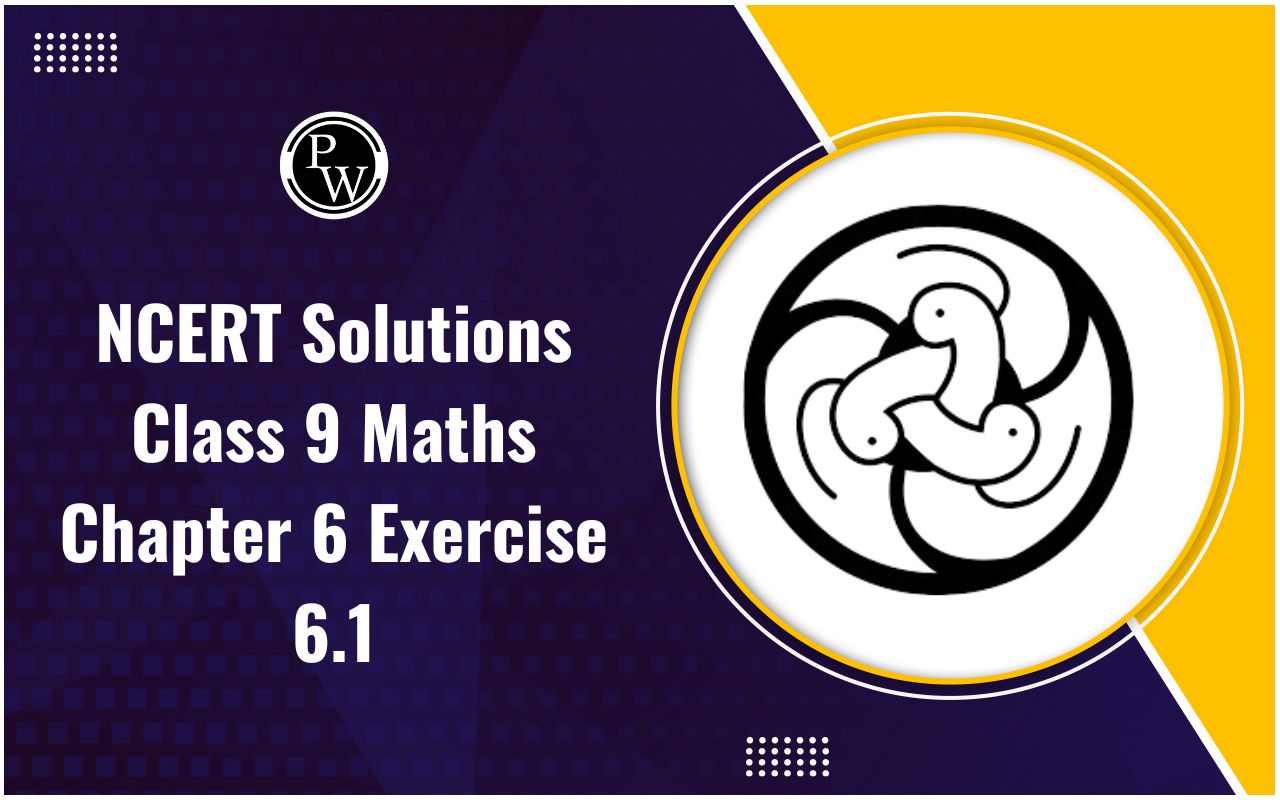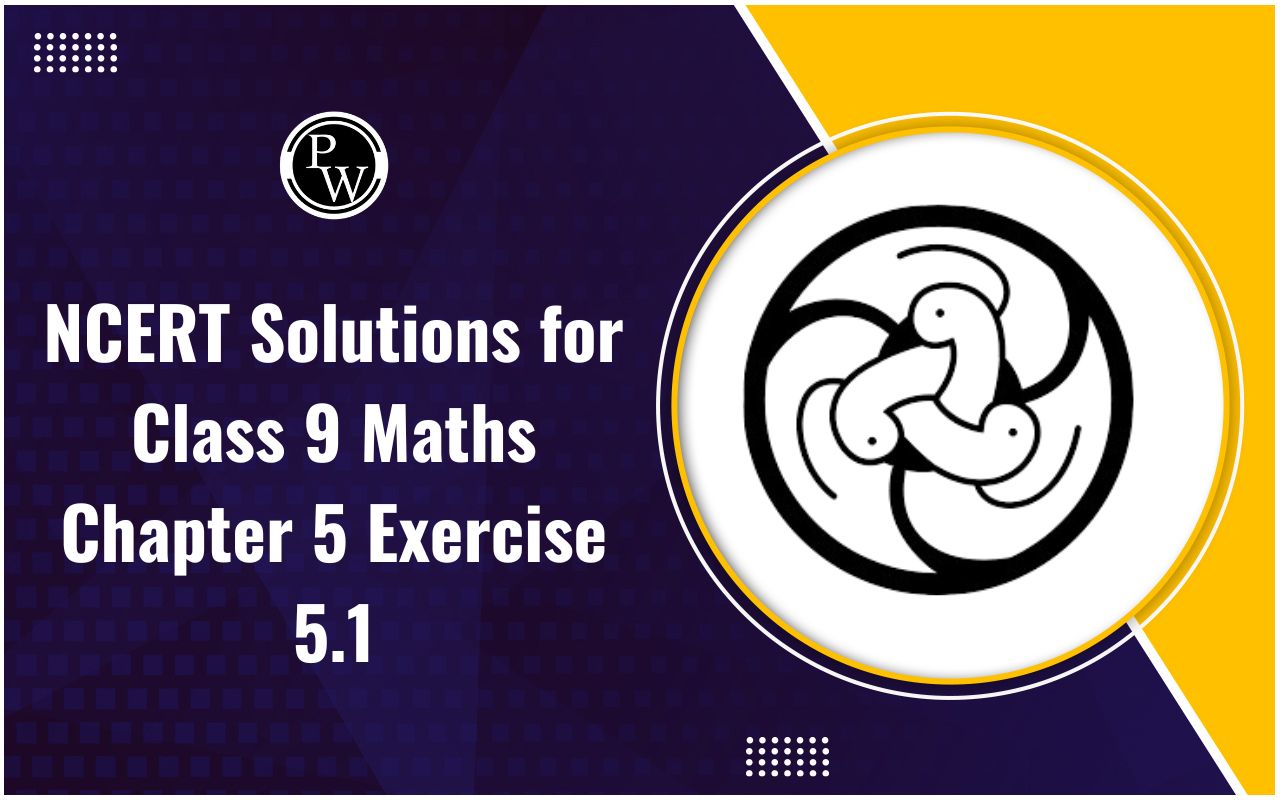

RS Aggarwal Solutions Class 9 Maths Chapter 9: Congruent triangles are those with corresponding sides and angles that are equal. Understanding congruence helps solve geometry problems and prove theorems.
This chapter also covers triangle inequalities, which are rules about the relationships between the sides and angles of triangles. By studying this chapter, students can improve their understanding of geometry concepts and become better at solving math problems.RS Aggarwal Solutions Class 9 Maths Chapter 9 Congruence of Triangles and Inequalities in a Triangle PDF
You can access the PDF for RS Aggarwal Solutions Class 9 Maths Chapter 9 - "Congruence of Triangles and Inequalities in a Triangle" by following the link provided below:RS Aggarwal Solutions Class 9 Maths Chapter 9 PDF
RS Aggarwal Solutions Class 9 Maths Chapter 9 Congruence of Triangles and Inequalities in a Triangle
The solutions for RS Aggarwal Class 9 Maths Chapter 9 - "Congruence of Triangles and Inequalities in a Triangle" are provided below. These solutions provide step-by-step explanations for each exercise, aiding students in understanding the concepts thoroughly. By referring to these solutions, students can enhance their problem-solving skills and prepare effectively for their exams. Whether it's proving congruence between triangles or solving problems related to inequalities in triangles, these solutions provide comprehensive assistance to students, ensuring clarity of concepts and boosting their confidence in mathematics.RS Aggarwal Solutions Class 9 Chapter 9 Congruence Of Triangles Inequalities In Triangle Exercise 9
Question 1.
Solution:
In ∆ABC, ∠B = 76° and ∠C = 48° But ∠A + ∠B + ∠C = 180° (Sum of angles of a triangle) => ∠A + 76° + 48° = 180° => ∠ A + 124° = 180° => ∠A= 180° – 124° = 56°Question 2.
Solution:
Angles of a triangle are in the ratio = 2:3:4 Let first angle = 2x then second angle = 3x and third angle = 4x 2x + 3x + 4x = 180° (Sum of angles of a triangle) = 9x = 180° = x = 180/9= 20° First angle = 2x = 2 x 20° = 40° Second angle = 3x = 3 x 20° = 60° and third angle = 4x = 4 x 20° = 80° Ans.Question 3.
Solution:
In ∆ABC, 3∠A = 4∠B = 6∠C = x (Suppose)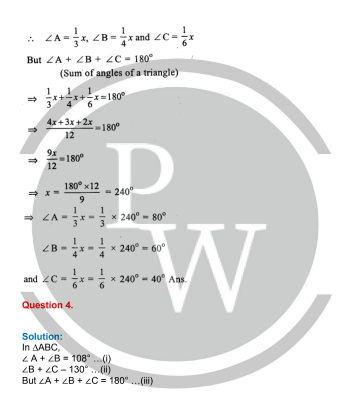 (sum of angles of a triangle)
Subtracting (i) from (iii),
∠C = 180° – 108° = 72°
Subtracting (ii) from (iii),
∠A = 180°- 130° = 50°
But ∠ A + ∠B = 108° (from i)
50° + ∠B = 108°
=> ∠B = 108° – 50° = 58°
Hence ∠A = 50°, ∠B = 58° and ∠C = 72° Ans.
(sum of angles of a triangle)
Subtracting (i) from (iii),
∠C = 180° – 108° = 72°
Subtracting (ii) from (iii),
∠A = 180°- 130° = 50°
But ∠ A + ∠B = 108° (from i)
50° + ∠B = 108°
=> ∠B = 108° – 50° = 58°
Hence ∠A = 50°, ∠B = 58° and ∠C = 72° Ans.
Question 5.
Solution:
In ∆ABC, ∠A+∠B = 125° ...(i) ∠A + ∠C = 113° ...(ii) But ∠A + ∠B + ∠C = 180° ...(iii) (sum of angles of a triangles) Subtracting, (i), from (iii), ∠C = 180°- 125° = 55° Subtracting (ii) from (iii), ∠B = 180°- 113° – 67° ∠A + ∠B = 125° ∠ A + 67° = 125° => ∠ A = 125° – 67° ∠A = 58° Hence ∠A = 58°, ∠B = 67° and ∠ C = 55° Ans.Question 6.
Solution:
In ∆ PQR, ∠ P – ∠ Q = 42° = ∠P = 42°+∠Q ...(i) ∠Q – ∠R = 21° ∠Q – 21°=∠R ...(ii) But ∠P + ∠Q + ∠R = 180° (Sum of angles of a triangles) 42° + ∠Q + ∠Q + ∠Q – 21°= 180° = 21° + 3∠Q = 180° = 3∠Q = 180°- 21° = 159° from ∠Q = 53° (i)∠P = 42° + ∠Q = 42° + 53° = 95° and from (ii) ∠R = ∠Q – 21° = 53° – 25° = 32° Hence ∠P = 95°, ∠Q = 53° and ∠R = 32° Ans.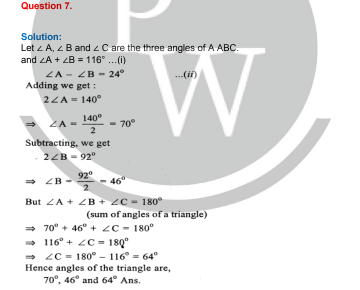
Question 8.
Solution:
Let ∠ A, ∠ B and ∠ C are the three angles of the ∆ ABC Let ∠ A = ∠ B = x then ∠C = x + 48° But ∠A + ∠B + ∠C = 180° (Sum of angles of a triangle) x + x + x + 18° = 180° = 3x + 18° = 180° = 3x = 180° – 18° = 162° x = 54° ∠A = 54°, ∠B = 54° and ∠C = 54° + 18° = 72° Hence angles are 54°, 54 and 72° Ans.Question 9.
Solution:
Let the smallest angle of a triangle = x° their second angle = 2x° and third angle = 3x° But sum of angle of a triangle = 180° x + 2x + 3x = 180° = 6x = 180° = x = 30° Hence smallest angle = 30° Second angle = 2 x 30° = 60° and third angle = 3 x 30° = 90° Ans.Question 10.
Solution:
In a right angled triangle. one angle is = 90° Sum of other two acute angles = 90° But one acute angle = 53° Second acute angle = 90° – 53° = 37° Hence angle of the triangle with be 90°, 53°, 37° Ans.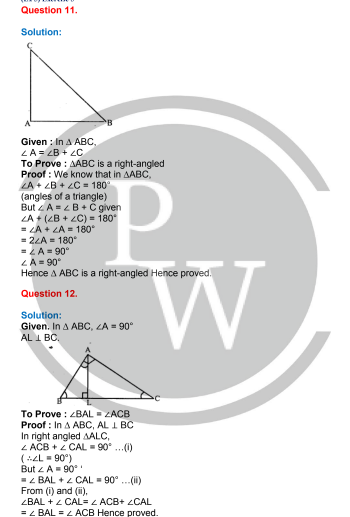
Question 13:
Solution:
Given. In ∆ABC, Each angle is less than the sum of the other two angles ∠A< ∠B + ∠C ∠B < ∠C + ∠A and ∠C< ∠A + ∠C Proof : ∠ A < ∠B + ∠C Adding ∠ A both sides, ∠A + ∠A < ∠A + ∠B + ∠C => 2 ∠ A < 180° (∴ ∠A+∠B+∠C=180°) ∠A = ∠A< 90 Similarly, we can prove that, ∠B < 90° and ∠C < 90° ∴ each angle is less than 90° Hence, triangle is an acute angled triangle. Hence proved.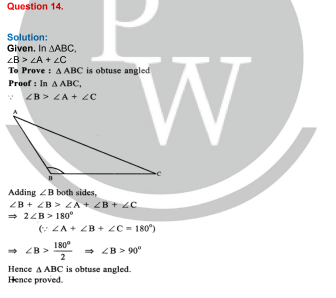
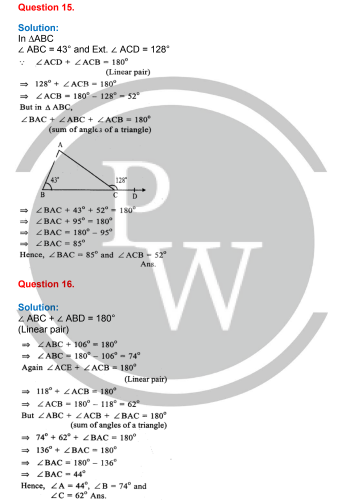
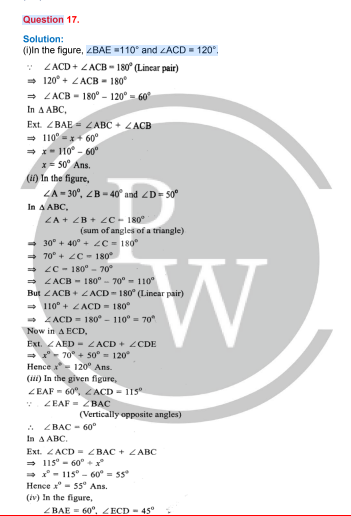

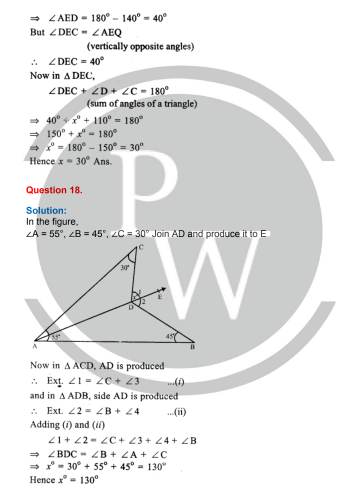

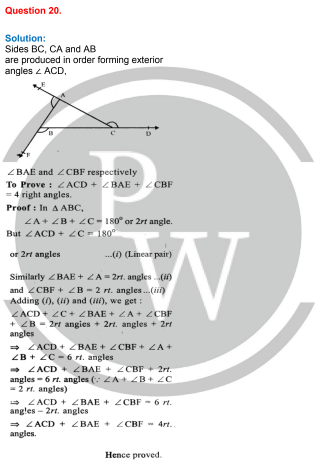
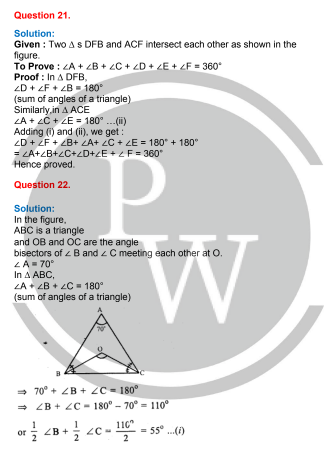
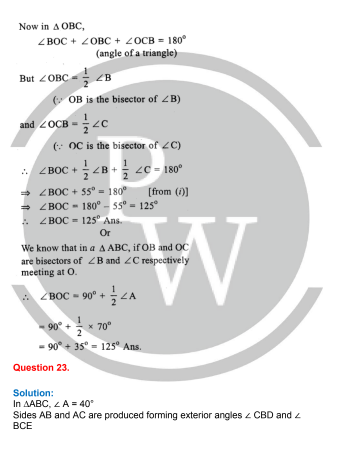
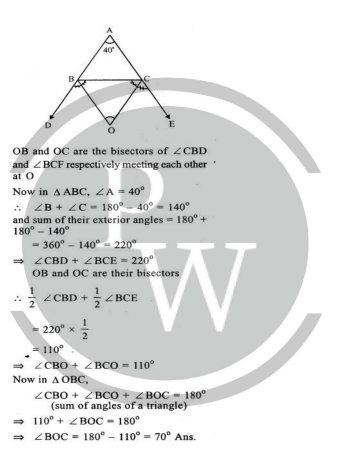

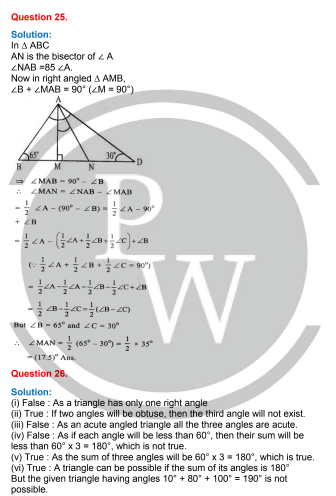
Benefits of RS Aggarwal Solutions Class 9 Maths Chapter 9 Congruence of Triangles and Inequalities in a Triangle
Here are the benefits of using RS Aggarwal Solutions Class 9 Maths Chapter 9 - "Congruence of Triangles and Inequalities in a Triangle" presented in points:- Conceptual Clarity: The solutions provide a clear explanation of the concepts related to congruence of triangles and inequalities in a triangle, helping students understand the topic better.
- Step-by-Step Guidance: Each problem is solved in a systematic manner, providing step-by-step guidance on how to approach and solve problems related to congruence and inequalities in triangles.
- Improved Problem-Solving Skills: By practicing with these solutions, students can enhance their problem-solving skills and learn different techniques to solve problems related to triangle congruence and inequalities.
- Confidence Building: Regular practice with these solutions can boost students' confidence in tackling questions on congruence and inequalities in triangles, preparing them well for exams.
- Comprehensive Coverage: The solutions cover all the important concepts and types of problems related to congruence and inequalities in triangles, ensuring comprehensive preparation for exams.
RS Aggarwal Solutions Class 9 Maths Chapter 9 FAQs
🔥 Trending Blogs
Talk to a counsellorHave doubts? Our support team will be happy to assist you!

Check out these Related Articles
Free Learning Resources
PW Books
Notes (Class 10-12)
PW Study Materials
Notes (Class 6-9)
Ncert Solutions
Govt Exams
Class 6th to 12th Online Courses
Govt Job Exams Courses
UPSC Coaching
Defence Exam Coaching
Gate Exam Coaching
Other Exams
Know about Physics Wallah
Physics Wallah is an Indian edtech platform that provides accessible & comprehensive learning experiences to students from Class 6th to postgraduate level. We also provide extensive NCERT solutions, sample paper, NEET, JEE Mains, BITSAT previous year papers & more such resources to students. Physics Wallah also caters to over 3.5 million registered students and over 78 lakh+ Youtube subscribers with 4.8 rating on its app.
We Stand Out because
We provide students with intensive courses with India’s qualified & experienced faculties & mentors. PW strives to make the learning experience comprehensive and accessible for students of all sections of society. We believe in empowering every single student who couldn't dream of a good career in engineering and medical field earlier.
Our Key Focus Areas
Physics Wallah's main focus is to make the learning experience as economical as possible for all students. With our affordable courses like Lakshya, Udaan and Arjuna and many others, we have been able to provide a platform for lakhs of aspirants. From providing Chemistry, Maths, Physics formula to giving e-books of eminent authors like RD Sharma, RS Aggarwal and Lakhmir Singh, PW focuses on every single student's need for preparation.
What Makes Us Different
Physics Wallah strives to develop a comprehensive pedagogical structure for students, where they get a state-of-the-art learning experience with study material and resources. Apart from catering students preparing for JEE Mains and NEET, PW also provides study material for each state board like Uttar Pradesh, Bihar, and others
Copyright © 2025 Physicswallah Limited All rights reserved.
Get App




